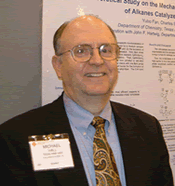
Michael Hall
Professor
Davidson Chair in Science
Our group applies "state-of-the-art" theoretical techniques to chemical problems of experimental interest in inorganic, organometallic, biological, and materials chemistry.
Methane is an underutilized commodity; would be a much more useful and valuable resource if it could be easily converted to other hydrocarbons such as ethylene. Such goals are the impetus for many research groups to study C-H bond activation. Detailed kinetics of the early stages of the C-H bonds activated by a tris-pyrazolylborate(Tp) rhodium carbonyl show the formation of two successive intermediates. Our preliminary calculations have identified these as a weakly solvated trihapto-Tp followed by a more strongly solvated dihapto-Tp complex, an interpretation that is quite different from the original ones suggested in the experimental work. Recent work has explained the unexpected dramatic change in C-H activation rates for cyclohexane vs. cycloheptane.
Much of our recent work has involved new developments in transition metal polyhydride complexes, particularly the transformation between non-classical dihydrogen complexes and classical hydrides. Among several studies are the recently reported, unexpected protonation of some group 6d pentahydrides. Oxygen transfer and insertion reactions are being examined in a model system that mimics enzymes. The stability and structure of transition metal carbon clusters, particularly the MCx systems studied by mass spectroscopy and the growth of MxCy clusters, are being investigated.
Because it would be valuable way to store solar energy, water splitting and the reduction of protons to hydrogen continue to be a major interest. Thus, much study has bee applied to understand how the enzyme, Hydrogenase, and related model complexes perform this reaction. Recent work has shown how the electron storage capacity of the nitrosyl ligand moderates the mechanism for electrochemical hydrogen production.
In addition to the nitrosyl ligand, other non-innocent ligands supported by transition metals play key roles in many important catalytic transformations. Recently, we have shown that the diazabutadiene ligand supported by ruthenium transforms methanol to carbon dioxide and hydrogen by a mechanism that involves proton and hydride transfers to the ligand framework rather than the metal. Thus, the transition metal plays the 'spectator' role in this system, which could be utilized for converting hydrogen into a liquid fuel.
B. S., 1966, Juniata College
Ph. D., 1971, University of Wisconsin, Madison
AEI Research Fellow, 1971-72, University of Manchester
Research Associate, 1973-74, Univ. of Wisconsin